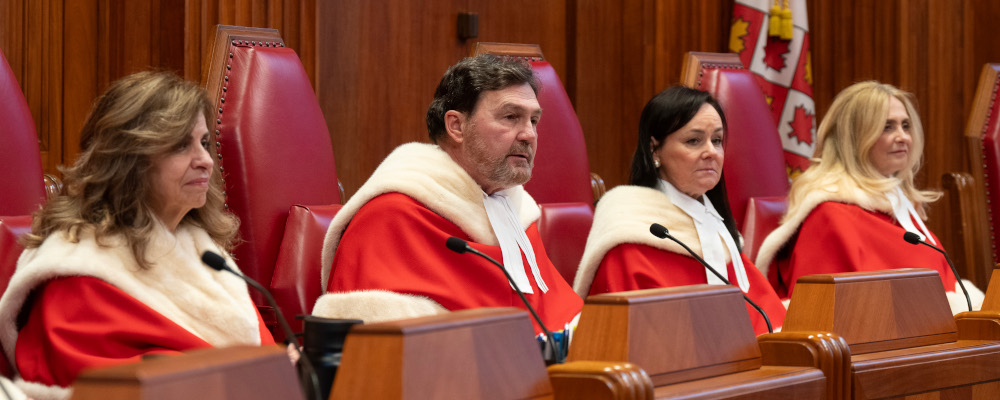The debate over the use of the notwithstanding clause is often framed as a struggle for supremacy between the legislature and the courts, where the side one favours depends on whether one trusts the courts more than the legislature or vice versa. This view misunderstands the problem.
It is not that the legislature is bad and the courts are good, or the other way around. The problem is that crafting laws to promote a just and prosperous society is very difficult. The legislatures and the courts have distinct strengths and weaknesses to bring to bear on this task. I propose that a responsive use of the notwithstanding clause can engage both bodies in a dialogue that builds on their respective strengths to craft laws that respect Charter rights more perfectly than either body can achieve on its own.
I recently wrote an article for The Hub criticizing a decision of the Supreme Court of British Columbia which implied that there may be a Charter right to use fentanyl in public parks. I concluded that “the time has come for the notwithstanding clause to be used routinely.” This article elaborates on what that “routine” use should look like.
The use of the notwithstanding clause has typically been pre-emptive, in the sense that it is invoked in the original legislation before any court has ruled on its constitutionality. The problem with the pre-emptive use of the notwithstanding clause is that it signals a dismissive attitude towards Charter rights and the courts. It suggests that the legislature doesn’t care about Charter rights, or at least that the legislature doesn’t care what the courts think about Charter rights. What’s more, because it completely shields the legislation from judicial scrutiny, it fails to take advantage of the courts’ insights into whether the legislation respects the Charter.

Instead of a pre-emptive use of the notwithstanding clause, I am arguing for a responsive use of the notwithstanding clause, invoked after the court has spoken. As I put it in my earlier article, the legislature should be able to say: “Thank you for your opinion, but on careful reconsideration, we disagree, and it is democratically elected representatives of the people who have the final say.” A responsive approach, unlike a pre-emptive approach, cares what the courts think—and relies on that perspective when making the final decisions that it, as the legislature, ultimately has the competency to make.
There are structural reasons why judicial oversight of legislative decisions is valuable. The courts are insulated from immediate political pressures and have a deep understanding of the inner workings of the legal system. The legislature, though democratically elected, may be tempted to ride roughshod over the interests of one group in pursuit of a popular agenda. A legislature pursuing a tough-on-crime agenda may find it politically convenient to ignore the rights of an accused in a manner that secures more convictions, at the risk of jailing the innocent. The Charter allows the courts to remind the legislature that the power of the state must be constrained if justice is to prevail.
While the courts have structural advantages, they also have structural shortcomings. As the Supreme Court of British Columbia’s fentanyl park decision illustrates, Charter cases often involve the balancing of rights and interests affecting many more people than those who are represented in the court proceeding. The legislatures are better suited to balancing a wide range of competing interests in multipolar issues. This means that just as the legislature may unjustifiably infringe on individual rights in the pursuit of legitimate objectives, so the courts may overreach when trying to protect those rights in a multipolar context. This is an increasing concern as the trend of Charter jurisprudence in the five decades since the Charter was adopted has seen the reach of the Charter extend further into multipolar policy issues, places where the court’s advantages of isolation from political pressure and unique knowledge of the law do not weigh as heavily in comparison with the courts’ deficiencies in representation and scope. Moreover, the Charter should reflect widely shared, fundamental values, and in these penumbral areas the values of the judiciary, drawn from a stratified educational and socioeconomic class, are more likely to diverge from those of ordinary Canadians.
The view that the notwithstanding clause should rarely, if ever, be used, implies that Charter rights need to be defended by the courts against attack from legislators. But Charter rights are valued by all Canadians—by our elected representatives as much as by the courts. After all, it was our elected representatives who adopted the Charter on our behalf. The responsive approach to the notwithstanding clause considers that the legislators and the courts are not adversaries but rather collaborators; they are engaged in a joint enterprise of interpreting and applying the Charter, using the strengths of one institution to complement the shortcomings of the other.
The fact that the Charter has a notwithstanding clause shows that it was always intended that the legislature have the final word; the question is how to bring the strengths of the judiciary to bear on the relevant legislation.
In a responsive use of the notwithstanding clause, a Charter challenge would wind its way through the courts in the normal manner until appeals are exhausted—even to the Supreme Court of Canada if that is where the litigation process takes it. A responsive use of the notwithstanding clause concerns what happens next, in those cases in which the final court holds the legislation to violate Charter rights.
Often, the response of the legislature will be to recognize that the legislation is indeed unconstitutional. In that case, the legislature need do no more. But in some cases, the legislature, on full consideration, may disagree with the Supreme Court. That should not be surprising—I doubt there is a legal scholar alive who believes that the Supreme Court has been entirely right on every decision in their area of expertise. There is no reason to believe the Supreme Court suddenly becomes infallible when it deals with Charter issues. In such cases, the legislature may choose to reintroduce the legislation, invoking the notwithstanding clause. In some cases, the legislature may decide the Supreme Court was partially right and reintroduce the legislation with amendments addressing some of the Charter violations identified by the Court, while using the notwithstanding clause to preserve other aspects of the legislation.
So far, none of this is new. It is what already happens when the legislature decides to invoke the notwithstanding clause in response to a judicial decision. A responsive use of the notwithstanding clause differs from the standard after-the-fact approach in two ways.
The first is a matter of attitude. The premise of the responsive approach is that the legislatures are just as legitimate interpreters of the Charter as the courts. When a legislature invokes the notwithstanding clause in response to a judicial decision, it is not because the legislature has decided to pass the legislation even though it violates the Charter; it is because the legislature has decided that the courts were wrong in their interpretation of the Charter—and it is the legislature that has the final say in how the Charter is to be interpreted.
The second is a matter of process. The legislature should explain why it believes the courts were wrong. Before reintroducing the legislation, the legislature should provide a detailed brief, explaining exactly why the notwithstanding clause is being invoked. There are many good reasons why the legislature might disagree with the decision of the Court. In a five-four decision of the Supreme Court, the legislature might reasonably say “We prefer the view of the minority.” If the Court itself considers the issue to be so closely balanced, it seems reasonable to allow the legislature to tilt the balance, rather than leaving the decision to the happenstance of the composition of the court.
If the Supreme Court reversed itself on a Charter point, the legislature might say “No thank you, we preferred the earlier version.” There might also be cases in which the legislature considers that the court has erred by not giving sufficient weight to the interests of the public at large, as I suggested was the case in the fentanyl park decision. In other cases, the legislature might have a substantive disagreement with the Court over the interpretation of the Charter. For example, if the Supreme Court were to hold that inconsistency with Charter “values” which are not found in the text of the Charter can be grounds for holding legislation unconstitutional, the legislature might reasonably say, “We prefer a textual approach.”

Whatever the reason might be, in a responsive use of the notwithstanding clause the legislature would explain in detail why it is choosing to depart from the Court’s decision in a way that is transparent and intelligible to the public. It is then for the public to decide whether it is the courts or the legislature that has the better measure of what the Charter means.
Understood in this manner, a responsive approach to the notwithstanding clause can be seen as reinforcing Charter rights rather than undermining them. Consequently, there is still a role for a pre-emptive use of the clause in some cases, for example, where the Charter landscape on a particular issue is well-established so that the legislature can predict the views of the courts. The pre-emptive use of the notwithstanding clause in such a case should be accompanied by the same kind of detailed explanatory statement as a responsive use.
Another difficulty with a responsive use of the notwithstanding clause is that litigation can be very costly and may delay the implementation of the legislation. In such cases, legislatures could use the clause in an interlocutory manner; that is, while it would be invoked at the outset, it would shield the legislation only for a limited time, perhaps until six months after all appeals are exhausted. If the final court declared the legislation unconstitutional, and the legislature agreed, the invocation of the clause would lapse automatically at the end of that period.
But if, after considering the reasons of the court, the legislature was of the view that the legislation was sound, it would have six months to prepare a responsive brief and re-enact it with the notwithstanding clause. Of course, such a use would strongly signal the legislature’s view of the legislation’s validity. But an interlocutory invocation of the clause would nonetheless invite the input of the courts in a way that a fully pre-emptive use does not.
A responsive use of the notwithstanding clause can prevent the politicization of the courts. In the United States, which does not have a notwithstanding clause, the Supreme Court is the final arbiter of many of the most important issues facing society. This inevitably leads to politicization of the courts, as the elected representatives pursue their political agenda through the judicial appointments process. With a responsive use of the notwithstanding clause, the government of the day can make judicial appointments without excessive regard to the politics of the judge knowing that political control remains with the legislature.
More fundamentally, a responsive use of the notwithstanding clause rejects the notion that the Charter is a weapon used by the courts to defend against depredations of the legislature. Instead, it views Charter interpretation as a dialogue between the courts and the legislature, which draws on the complementary strengths of each to arrive at the best interpretation of the Charter in the interest of all Canadians.
Recommended for You

The Notebook by Theo Argitis: Carney’s One Big Beautiful Tax Cut, and fresh budget lessons from the U.K.

Ginny Roth: How vacant liberal nationalism left Canada worse off than George Grant even imagined

Peter Menzies: Justin Trudeau’s legislative legacy is still haunting the Liberals

‘Our role is to ask uncomfortable questions’: The Full Press on why transgender issues are the third rail of Canadian journalism



